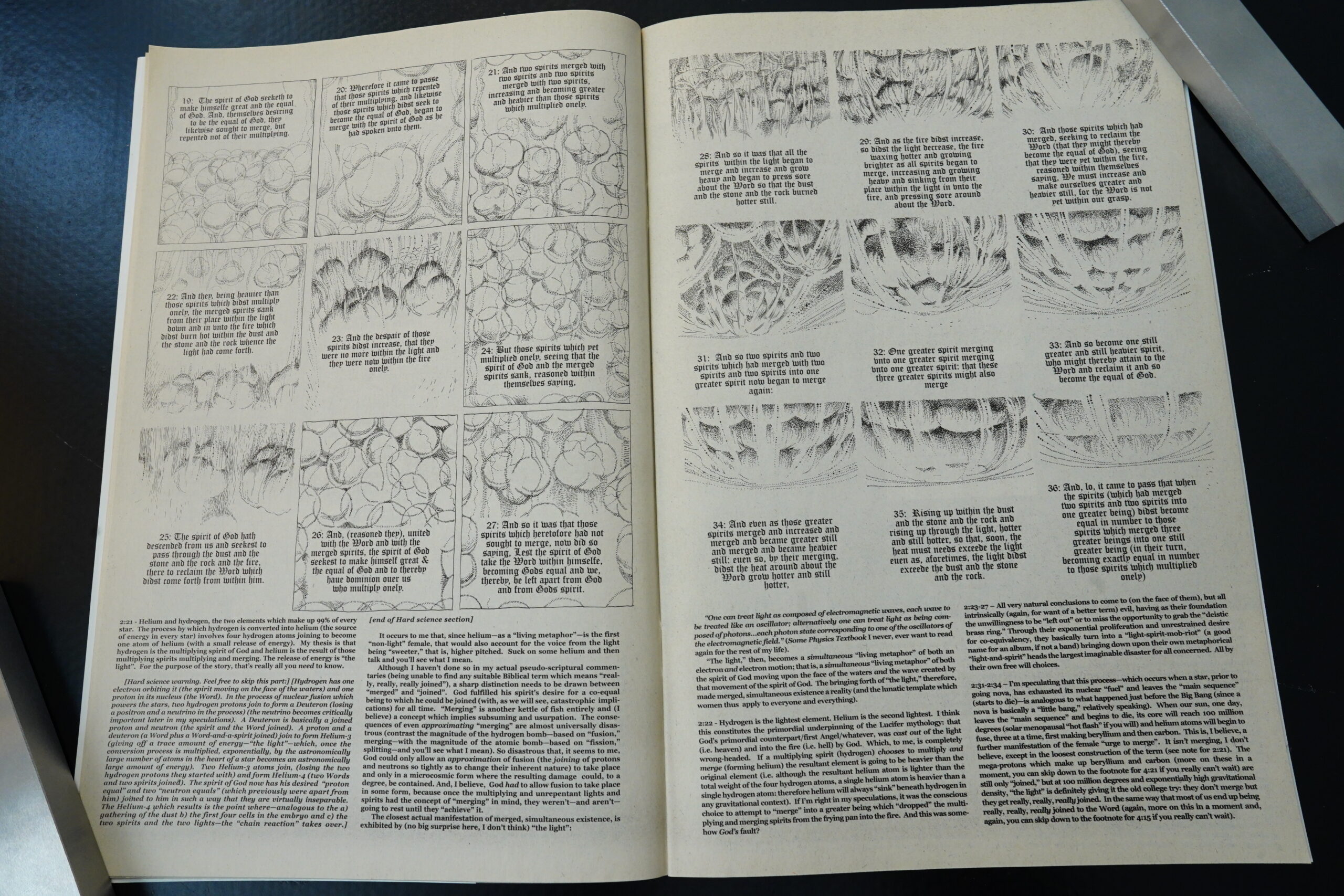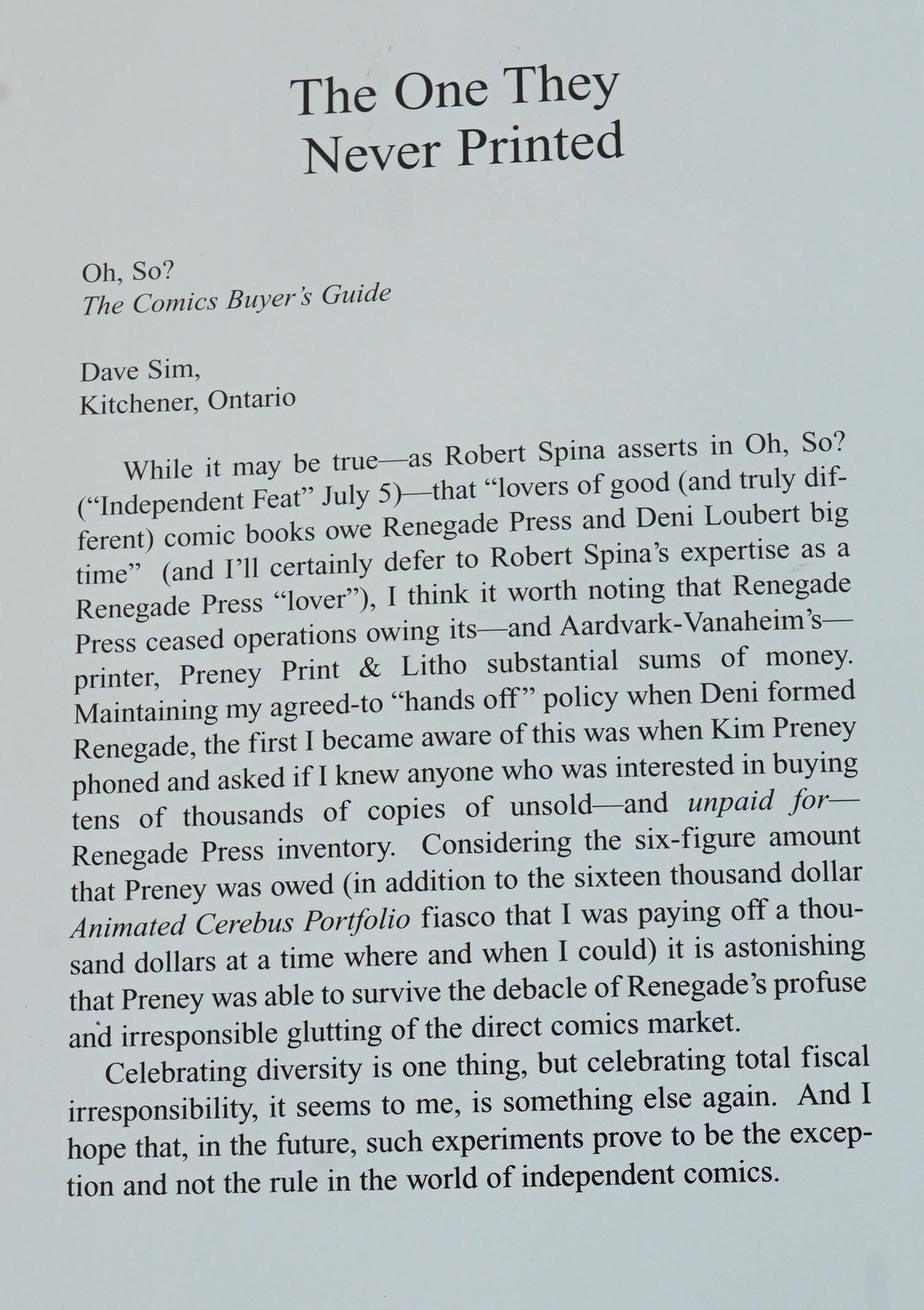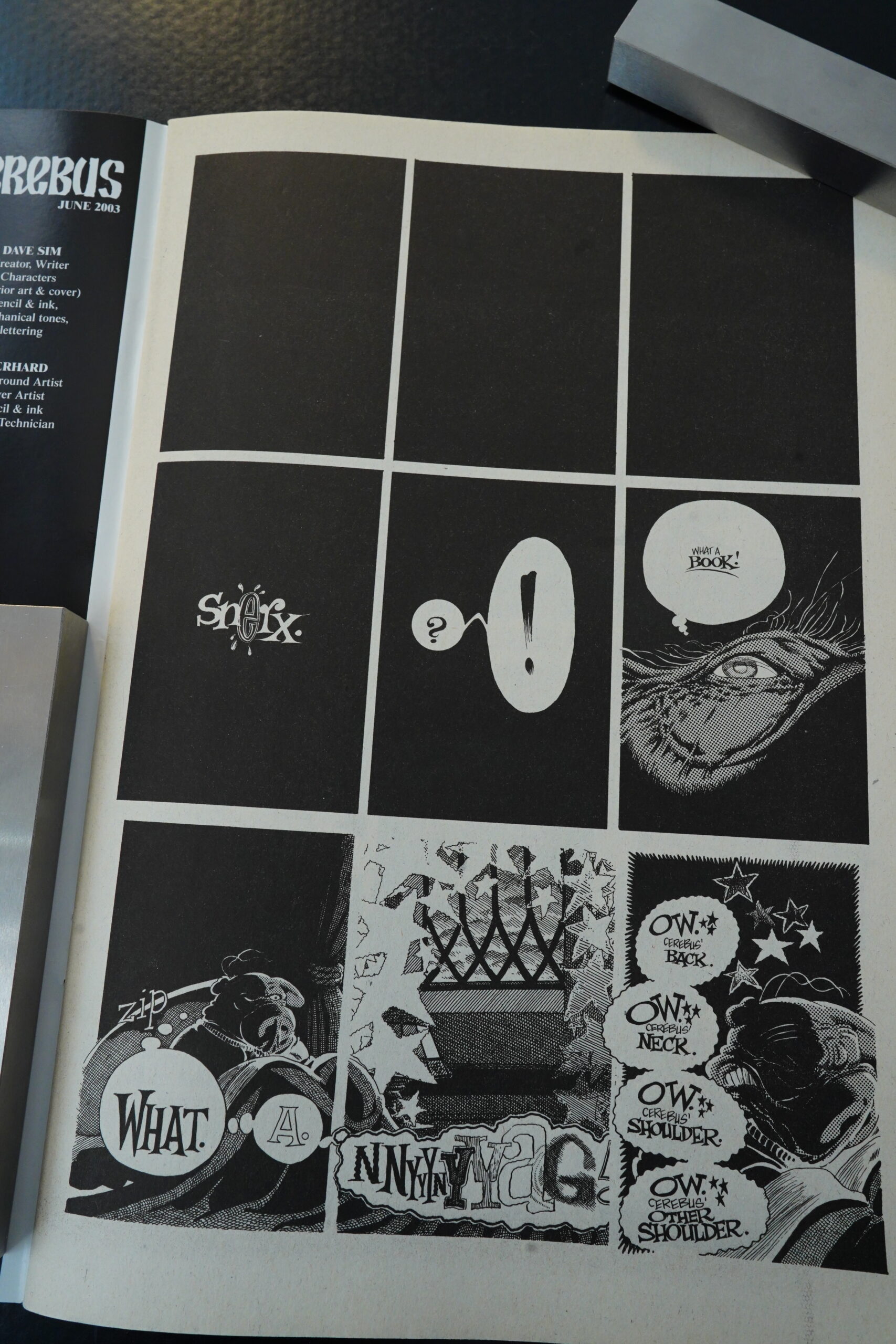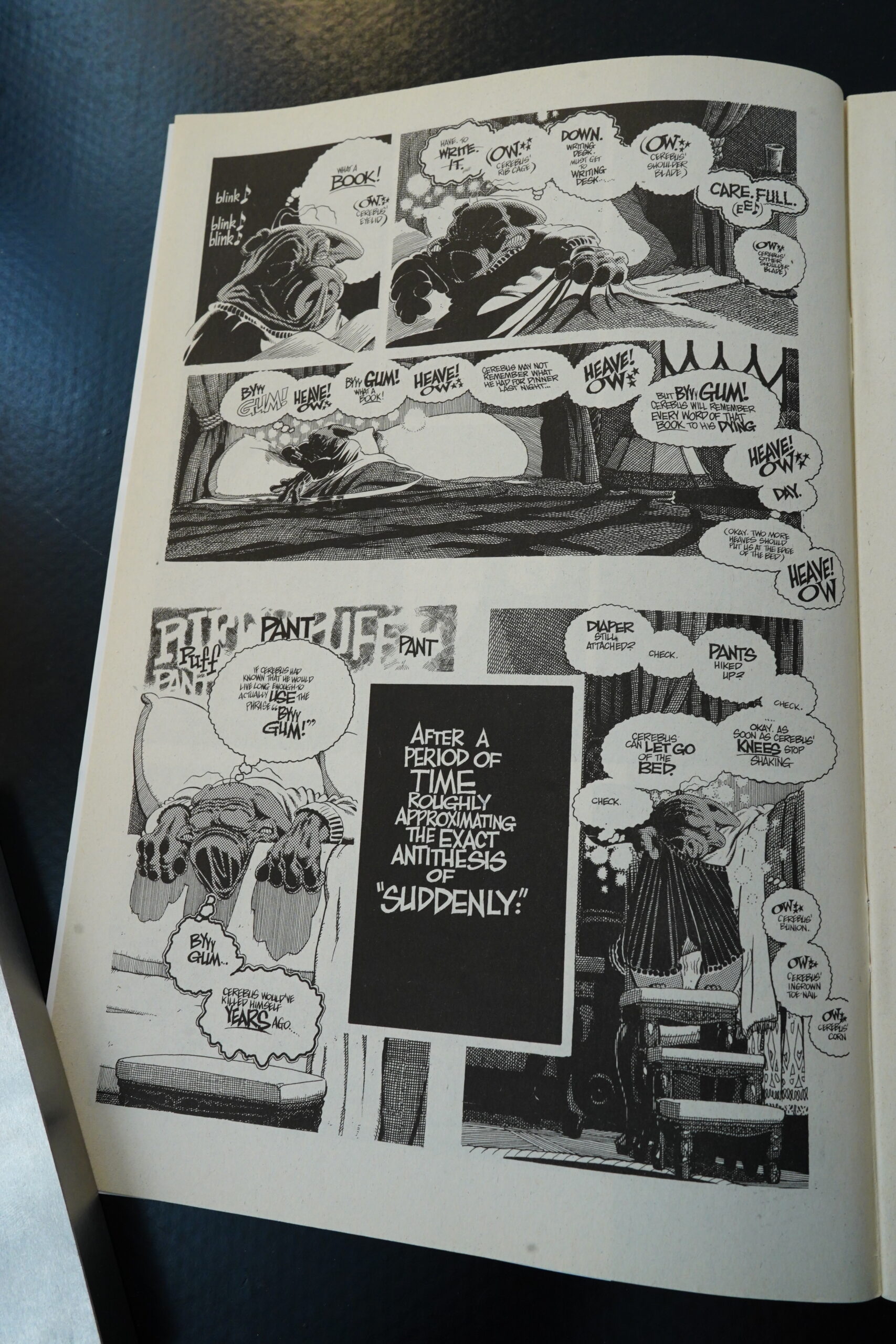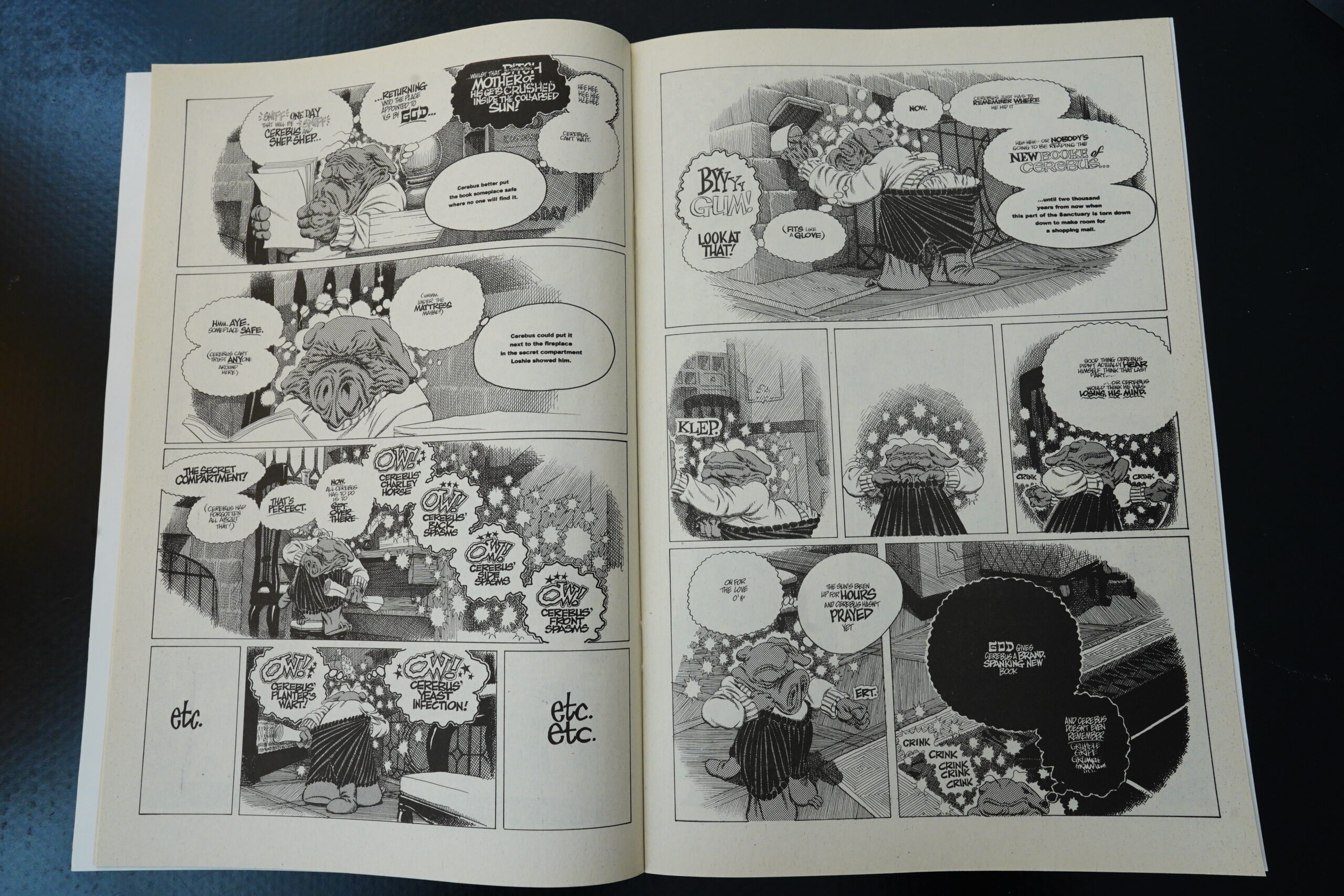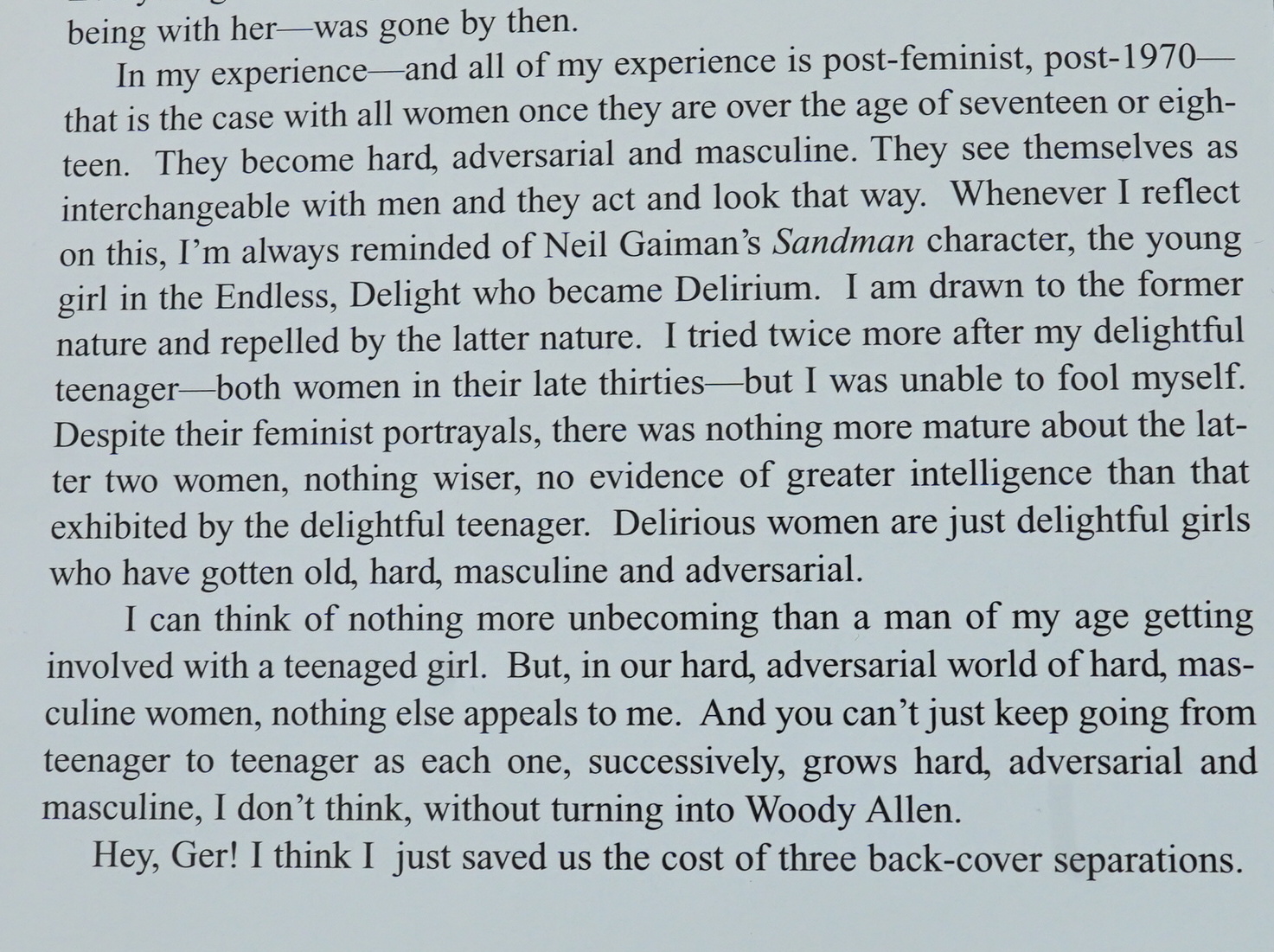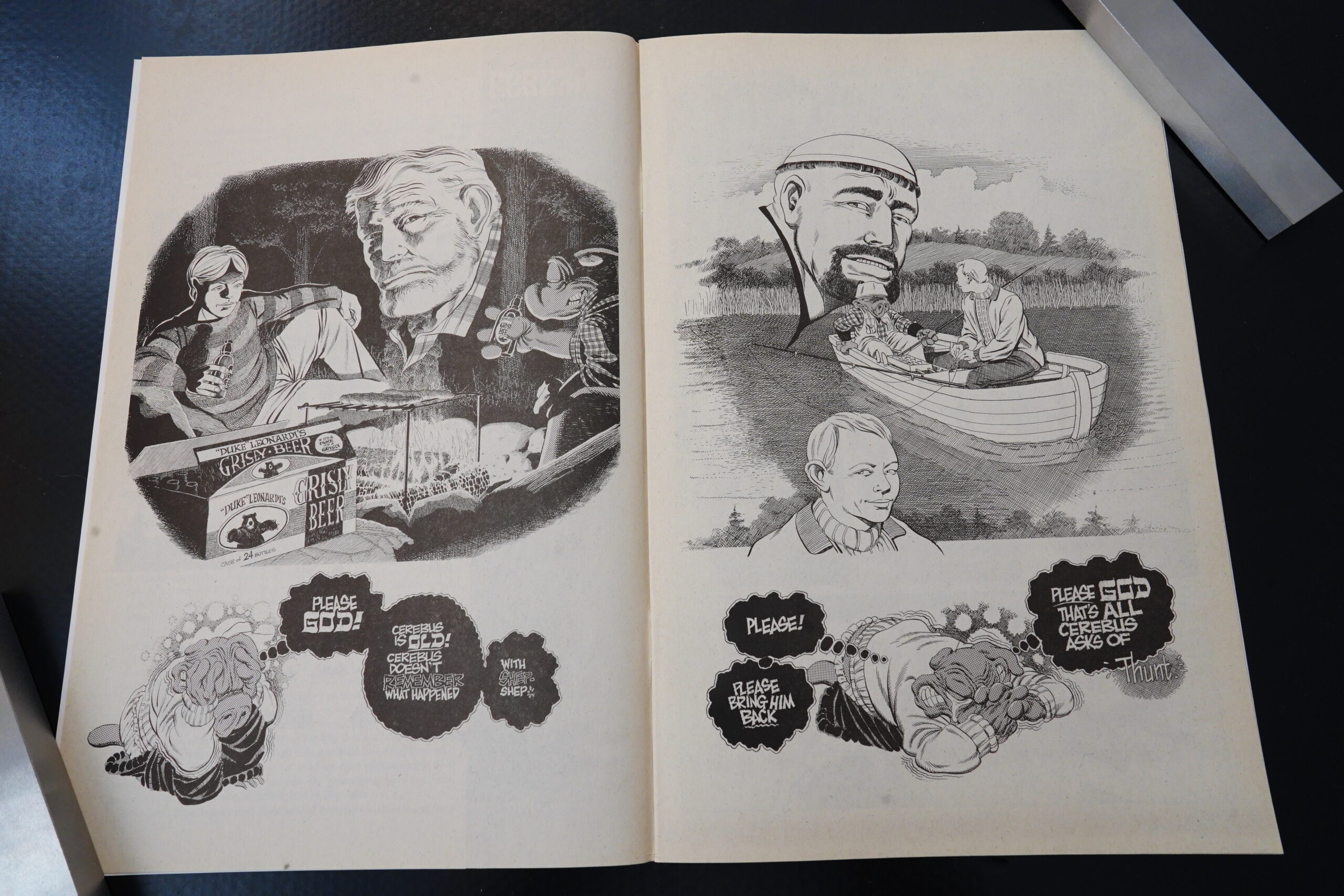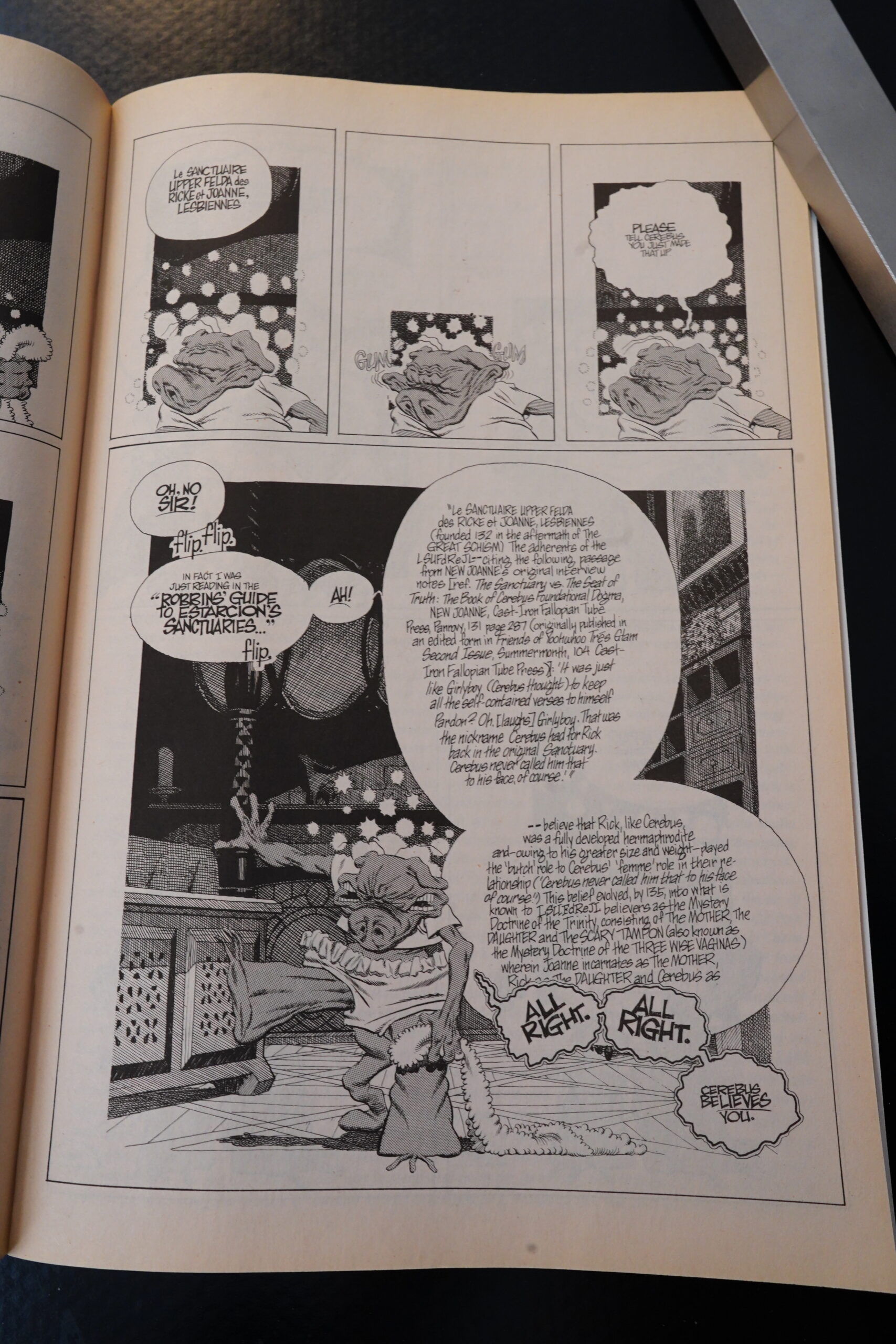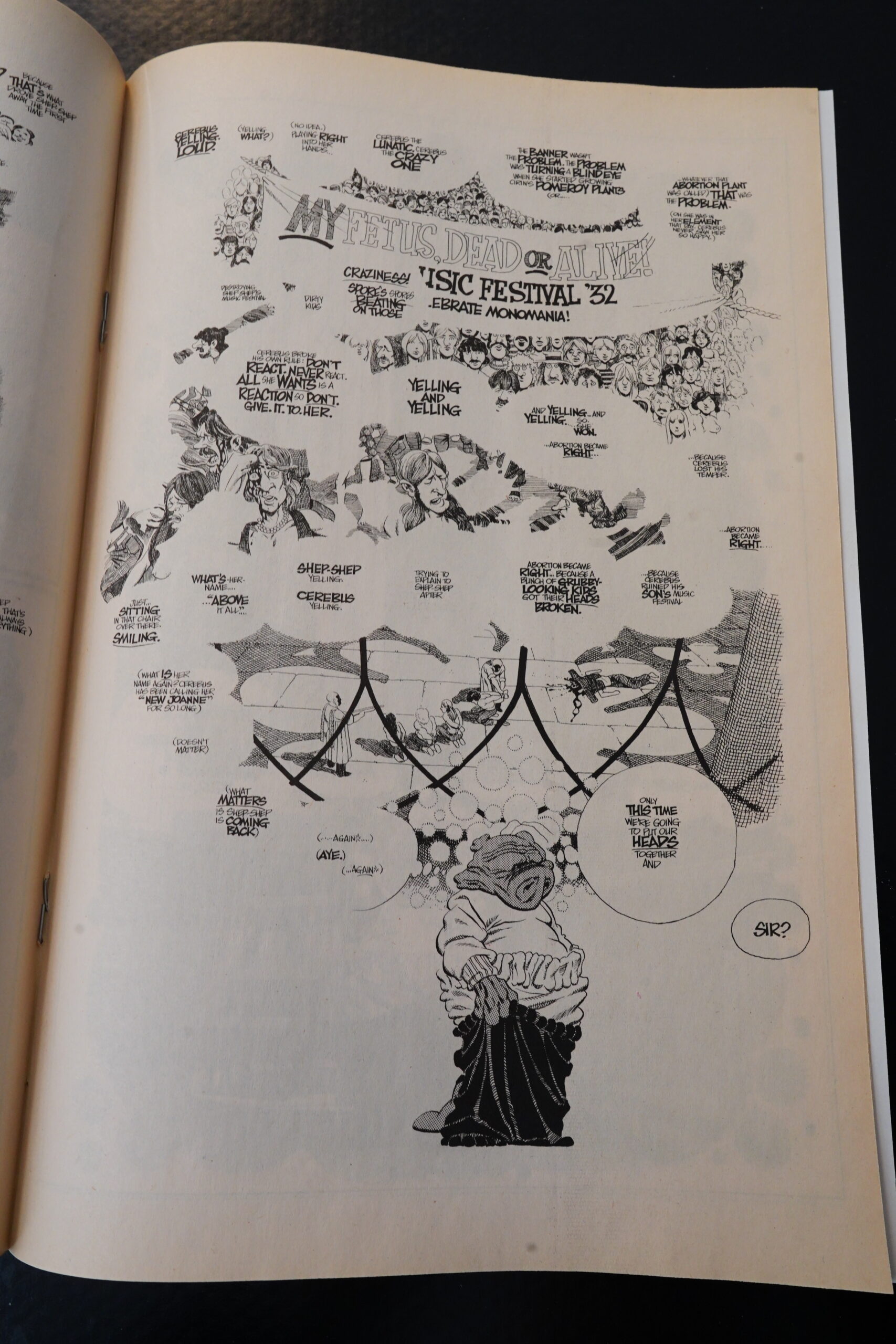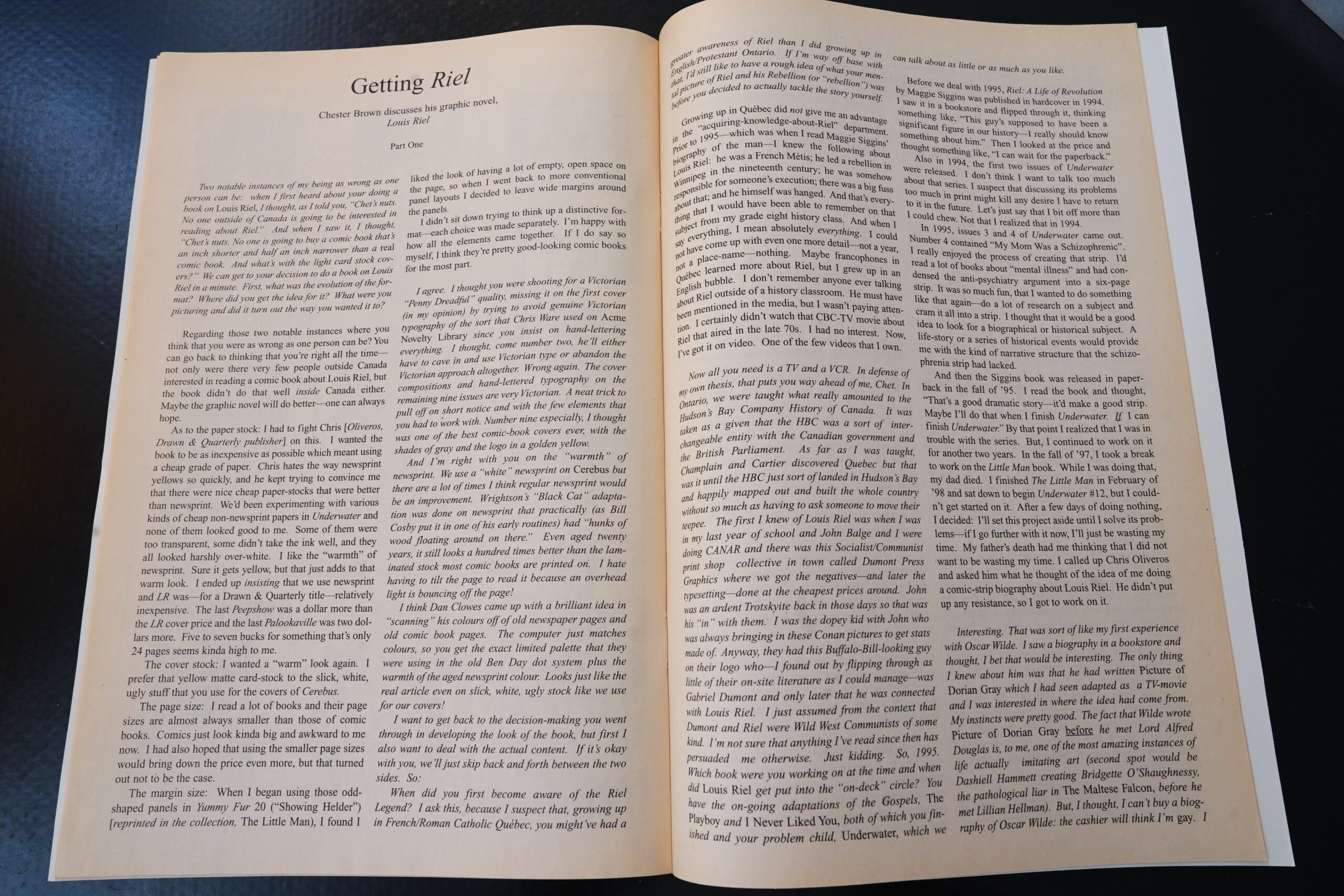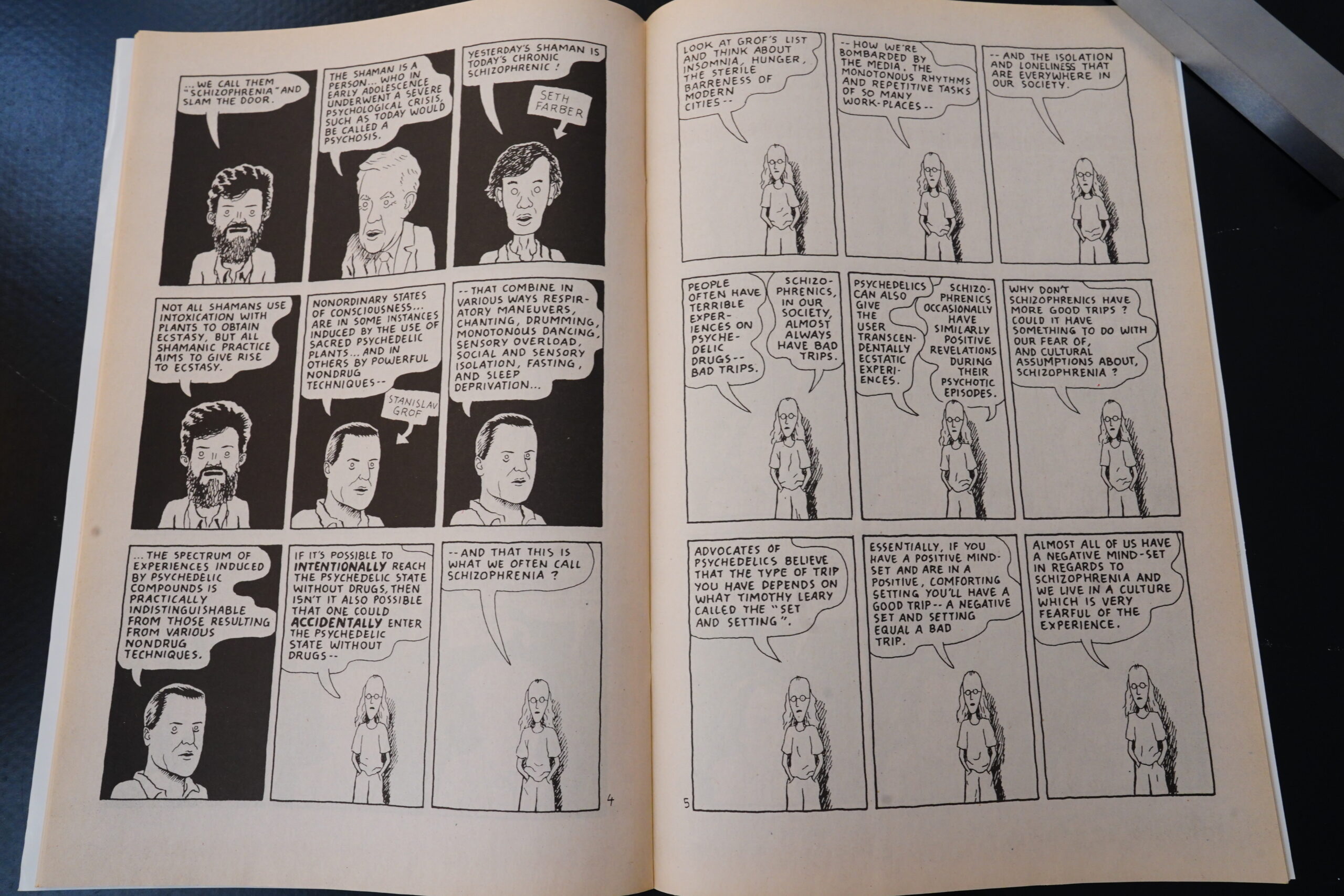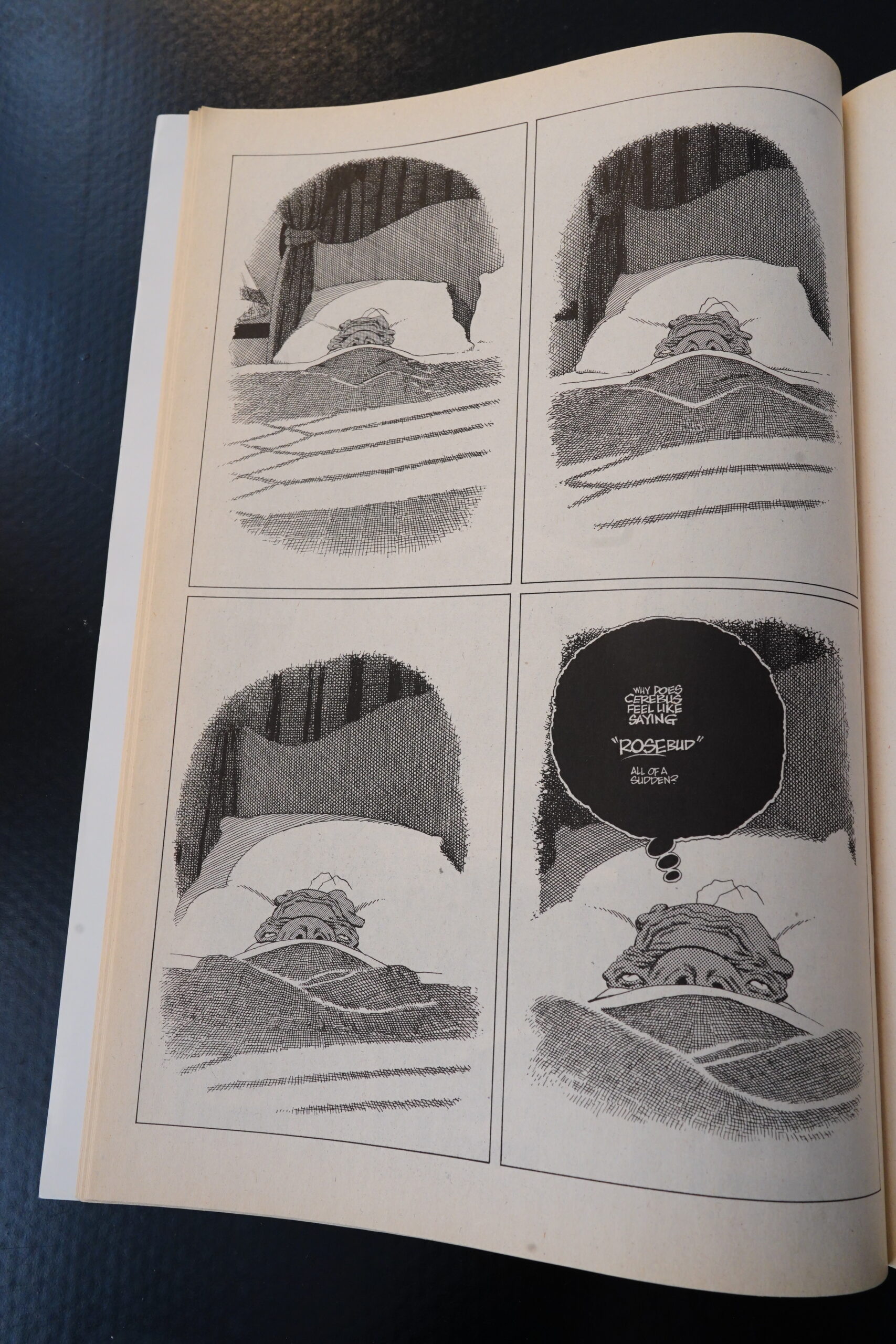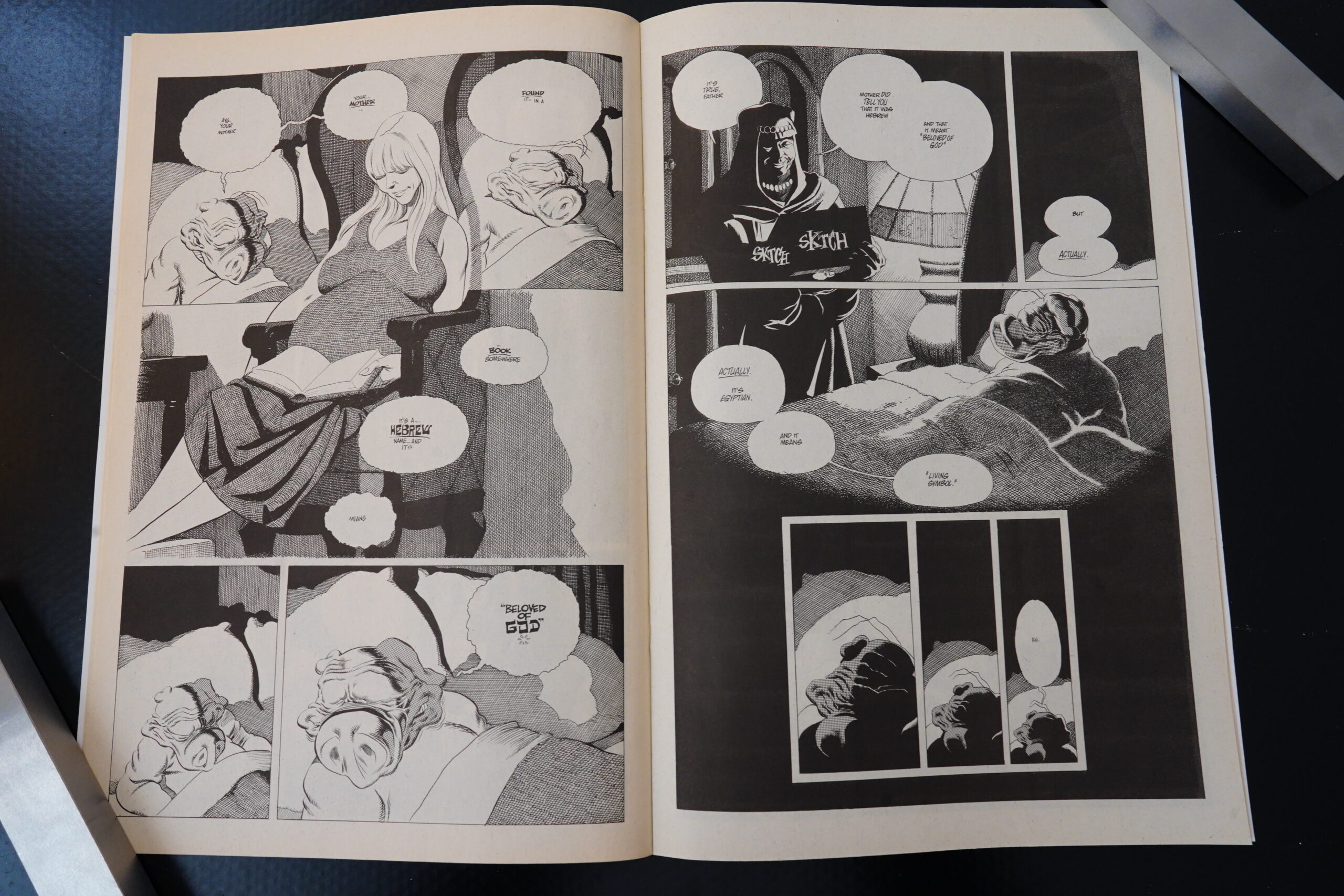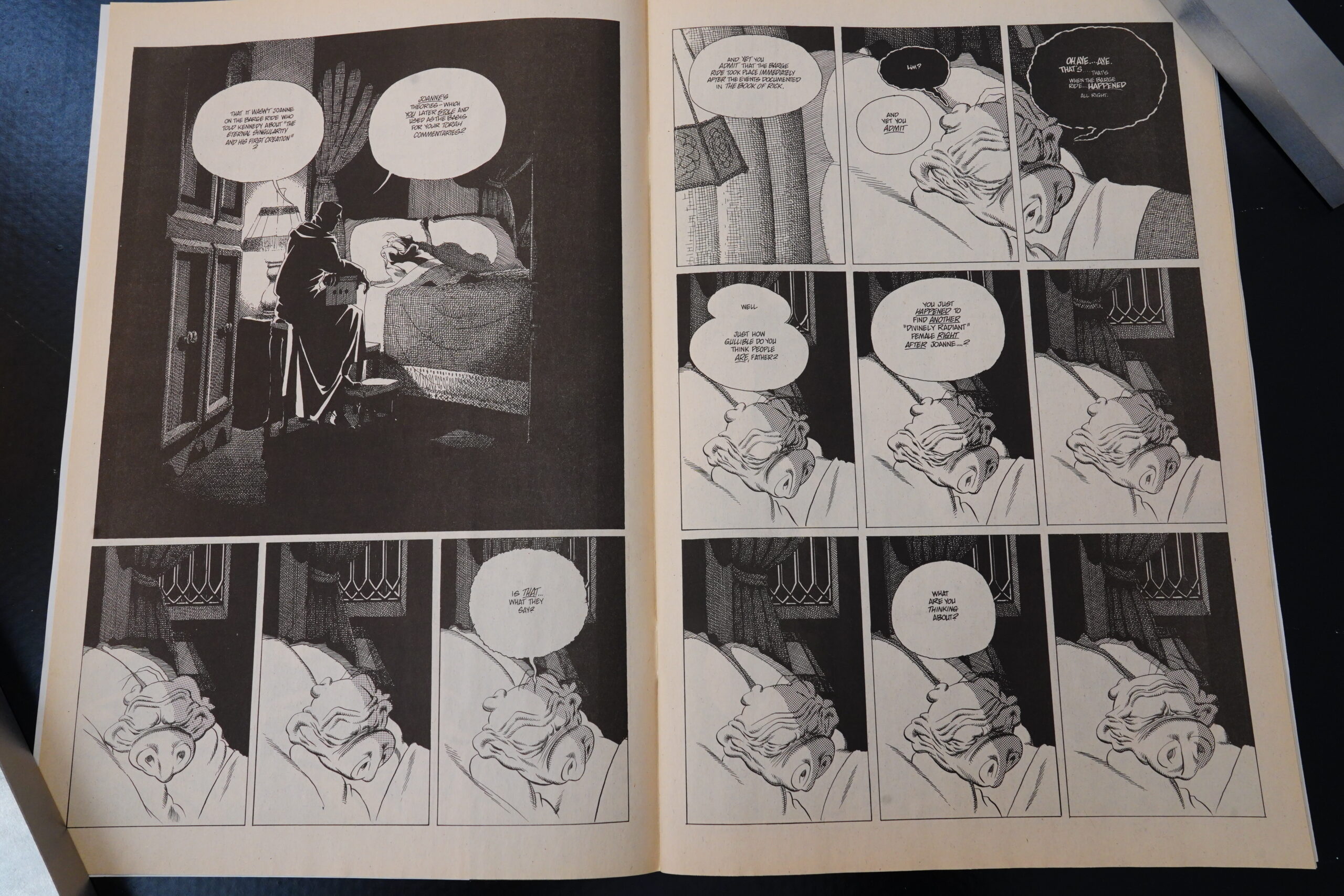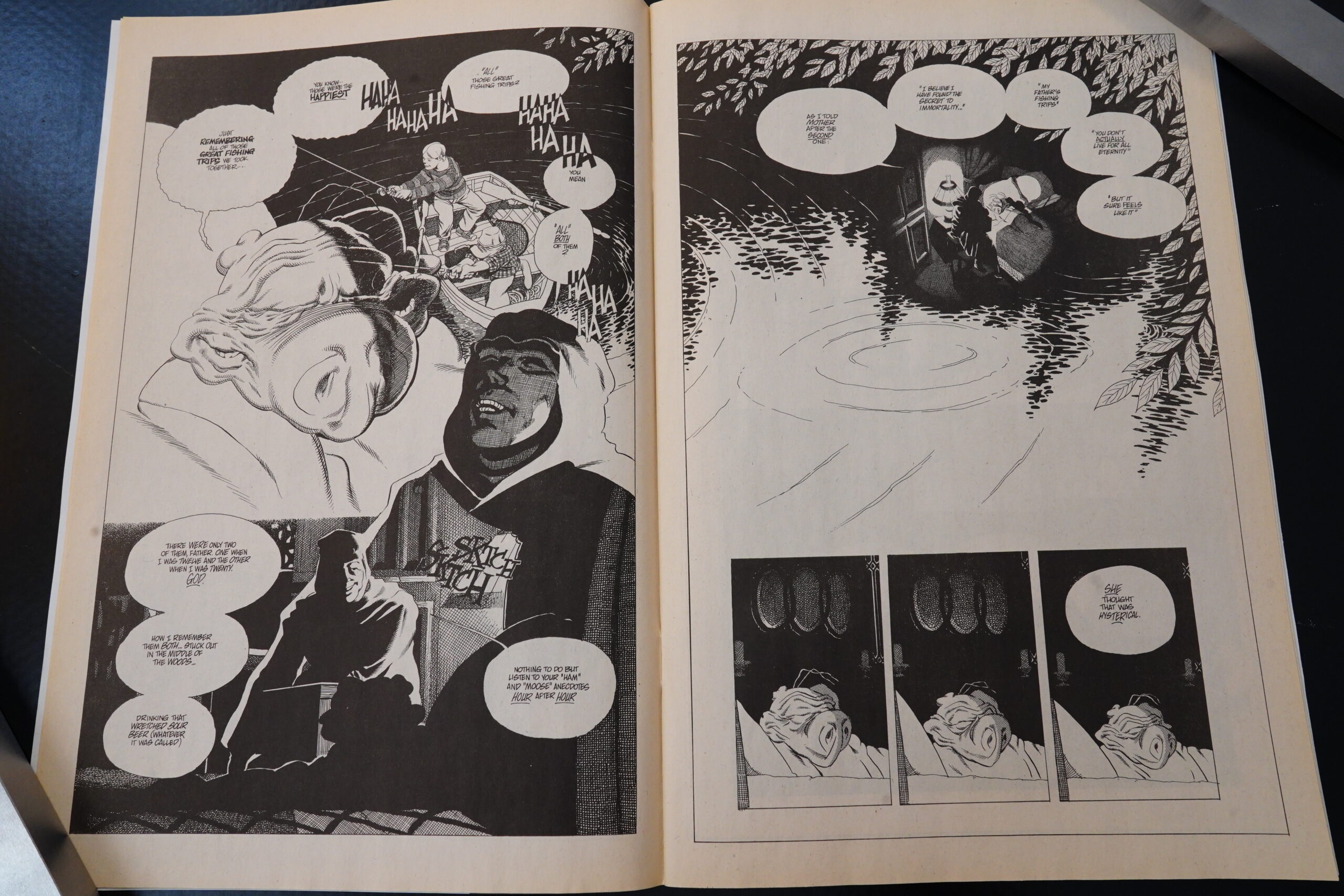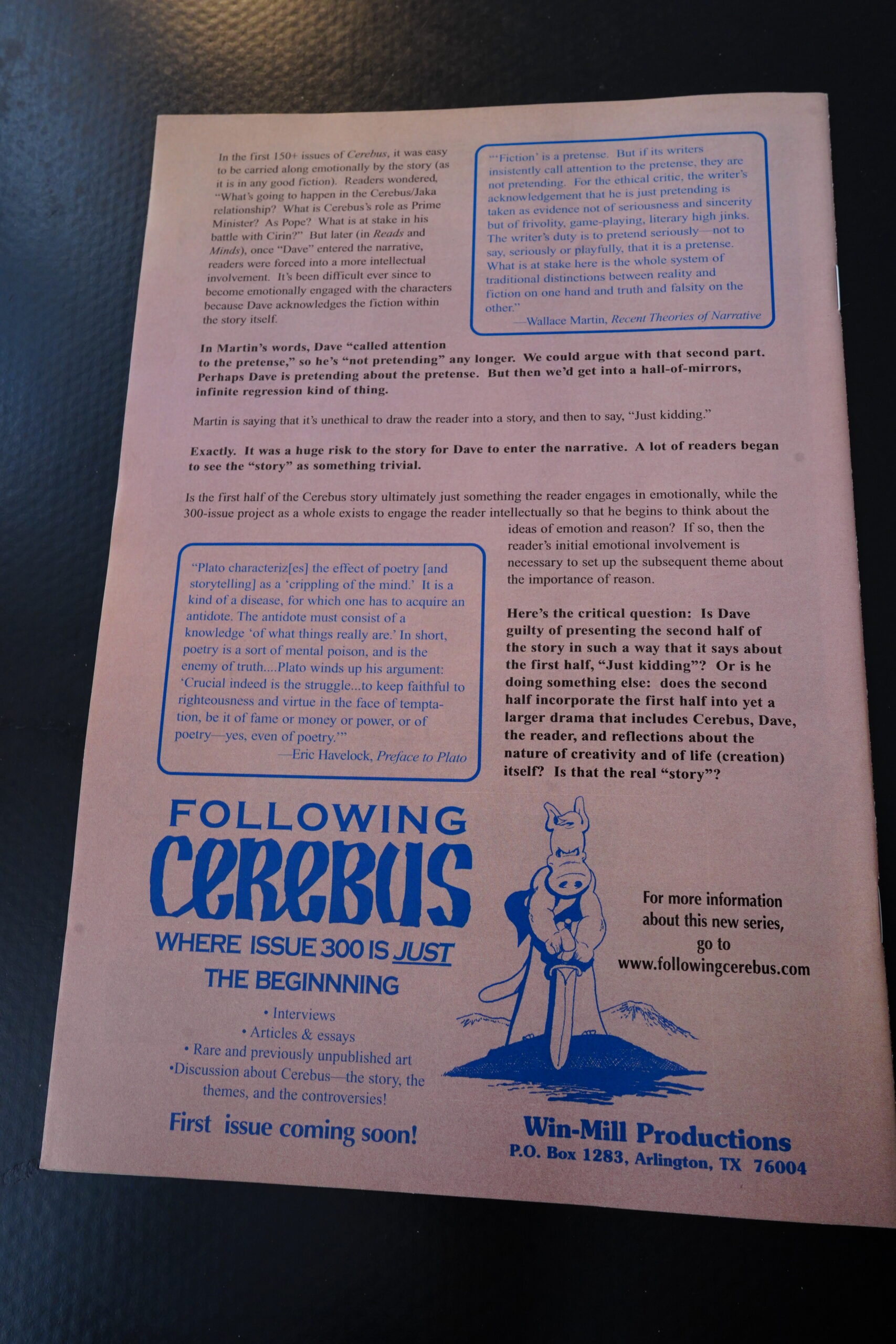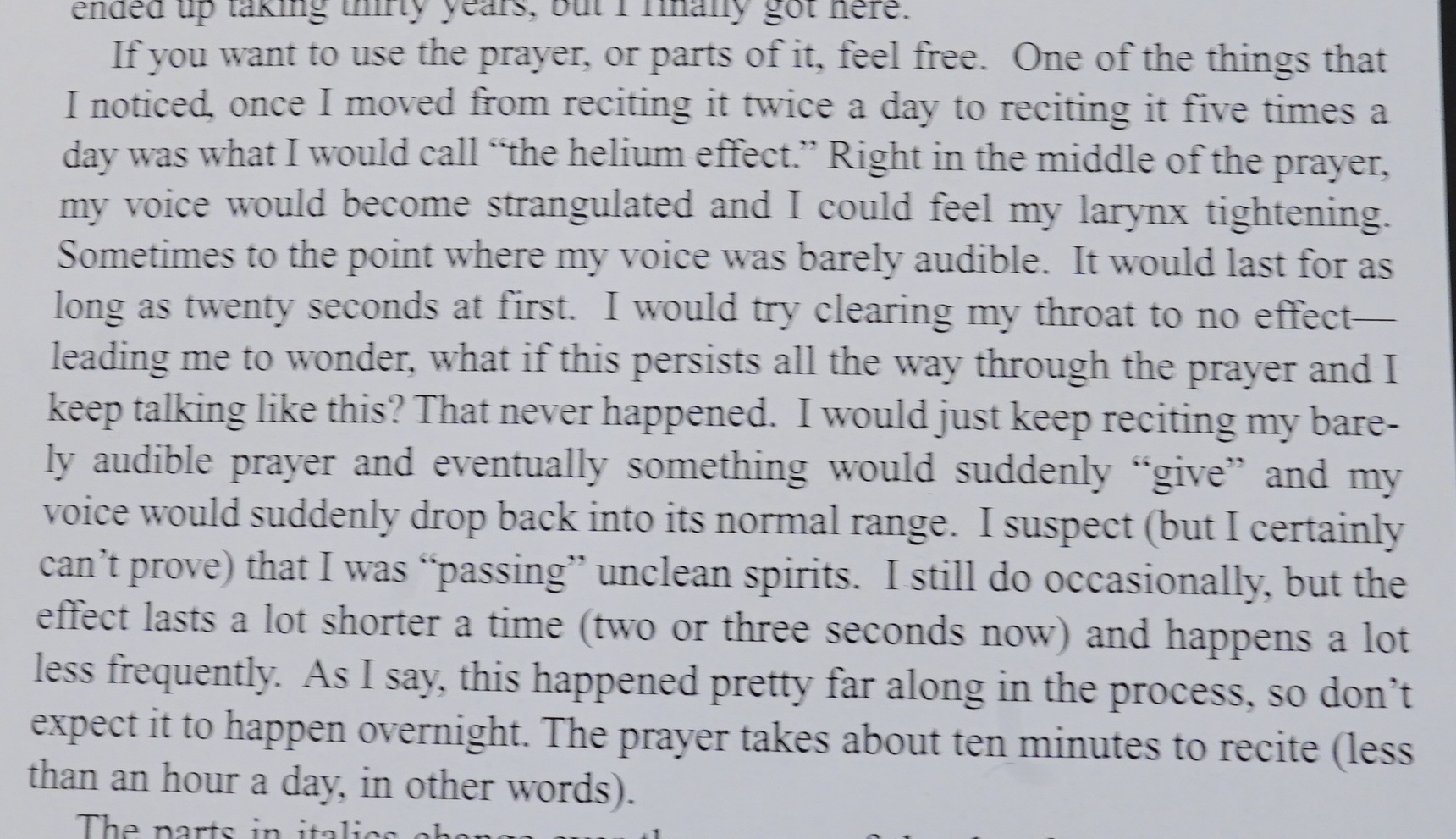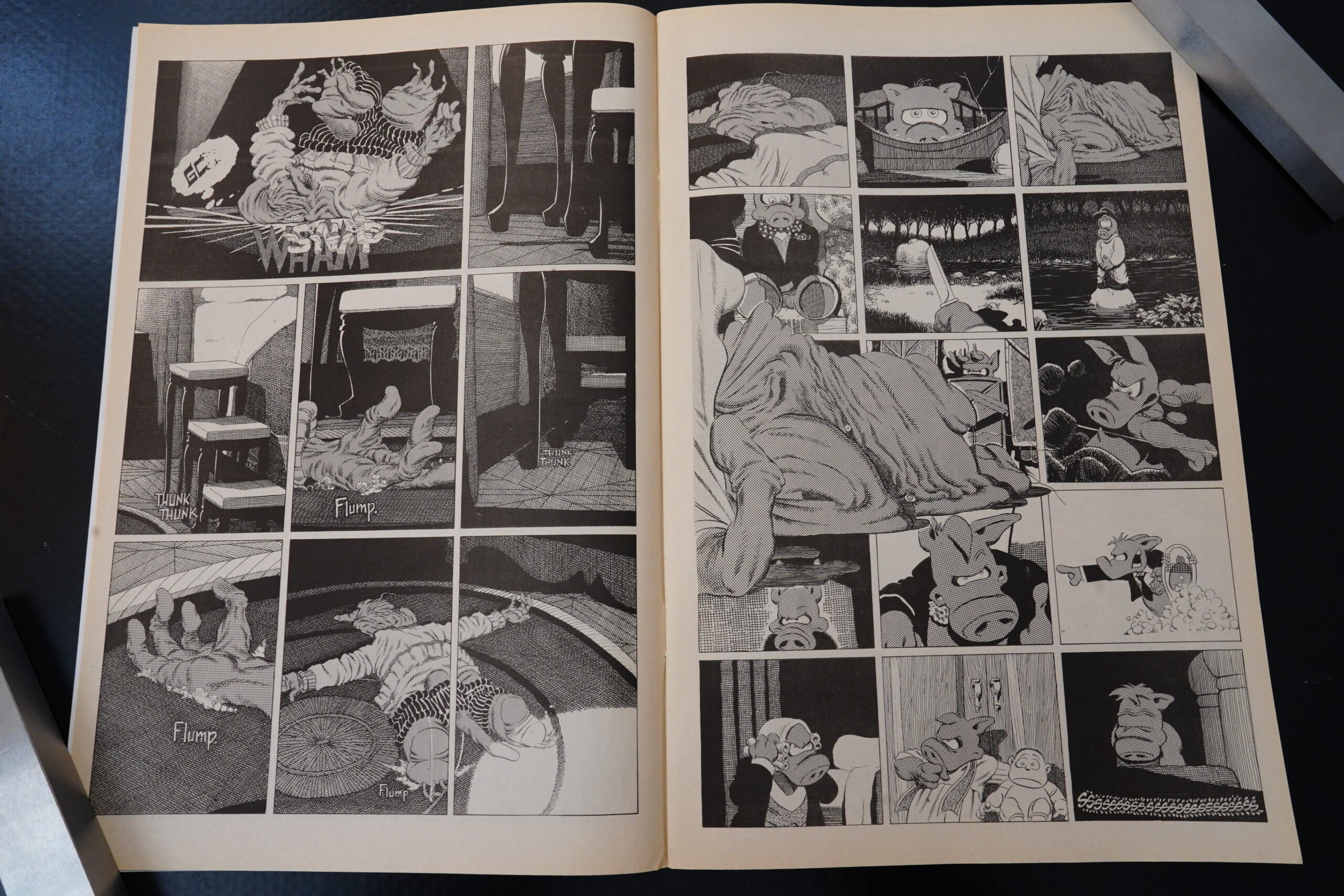Cerebus (2003) #289-300 by Dave Sim & Gerhard
Heh heh.
Anyway, this blog post covers the final Cerebus collection: The Last Day. It starts with a double sized/double numbered issue, #189/#190.
And… it’s all Bibley stuff. Cerebus is dreaming throughout the issue while God is apparently telling him how it really goes.
I’m not sure whether the commentary parts are part of the dream? Possibly…
There’s not a lot of artwork in this issue, but there’s some — presumably by Gerhard? I think that elephant looks Gerhardy, but I could be wrong.
The Comics Buyer’s Guide apparently didn’t print this letter where Dave Sim writes in to slag off his ex wife. While doing research on Renegade the other year, I think the conclusion was that she managed to pay off all the Renegade Press debts eventually? What I find interesting here, though, is that he talks about not having paid off the Animated Cerebus Portfolio when Renegade went under. Now, that portfolio was printed in 1983, and Renegade went under in 1988. But meanwhile, Sim had published the wildly successful High Society collection in 1986, so you’d think that (at least) would give Sim the $16K he owed Preney, but apparently he had better things to do with that money.
Comics Scene Volume #1, page 62:
DAVE: fie portfolio is 40 plates. Full color.
face of alternative comics.
For $10. We’re doing a portfolio of
storyboards for a proposed Cerebus
animated feature I’m initiating as a one-
hour TV special. That’s one reason for the
low price tag. I want to make sure that fans
get a good value for their money and conse-
quently, there will be a series of portfolios,
maybe eight, which will eventually be a
fair chunk of what the animated project
will be. And my ambition is to do an
animated film which doesn’t have a single
heartwarming moment.
CS: Are you going to kill Bambi’s mother?
DAVE: I want to do for Warner Brothers
animation what Don Bluth is doing for
Disney to bring back that lost style. I
want an animator who feels the same way,
and I’ll turn the project over to him as long
as he understands what I’m saying and can
tell me, “I’ll put it on film for you.” I’m not
interested in going to a studio like Disney
and having them impose their own vision
on Cerebus as they did with Pinocchio. It
has to be my story, the way I conceived it.
The Last Day, proper, starts off in issue #191 with Cerebus waking up and remembering the bibley text from his dream, and then setting out to get it down exactly.
Cerebus is, by this point, about 240 years old? Somebody had counted up the years and made a timeline… Cerebus himself guesses that he’s about 300 years old. Sim chooses to make the point, at exceeding lengths, that being this old sucks, so he has Cerebus do everything veeery slowly. Pages and pages and pages of Cerebus getting down from his bed or getting up on a chair. I mean, it’s well done, but it gets a bit tiresome.
Cerebus’ sanctuary is now a military compound.
Just to drive home that the text he’s putting down is really inspired by god — when he tries to change it (to favour his son), he’s struck by lightning.
And it looks like god is speaking in a typeset sans serif font, and tells Cerebus that the book he’s written will remain hidden for two thousand years, until they tear down the sanctuary to build a shopping mall. So that seems to indicate that all this is happening around the time of the start of our era? I had imagined that it took place, say, four thousand years ago, and that Estarcion had suffered a cataclysm that wiped it out… but whatever.
Sim explains that he’s celibate now because he only has the hots for 17 year old girls, and that’s pretty unbecoming for a man of his age — he’s “repelled” by women that are older than that.
After finishing writing god’s word, Cerebus becomes nostalgic and thinks about his son, Shep-Shep, and most of the rest of the series is about Cerebus trying to arrange a meeting with him (his son is 48 years old at this point).
Because Cerebus is now a prisoner, tied up by various rules and bureaucracies that he’s set up over the years.
Setting up the meeting is made especially difficult by various schisms within Cerebus’ church.
Oh yeah, the “While Canada Slept” essay continues for many, many pages — these are pretty long issues, upward of 48 pages.
Cerebus is somewhat senile at this point, but we get glimpses of his reign — this was apparently what led to the major schism in the church: His wife annoyed him so much that he had the participants at a music festival executed.
When the Canada essay ends, Sim starts a dialogue with Chester Brown about Brown’s Louis Riel book.
Estarcion is totes degenerate by now, so I’m guessing god smote (that’s a word) it right after Cerebus ends.
I think this ran in Underwater? It’s Brown’s strip about his schizophrenic mother.
Cerebus suffers a heart attack…
… and takes to bed. Sim can’t help himself and throws in a throwaway gag.
But then! Shep-Shep, who’s now apparently a Bedouin or something manages to gain entrance!
And it turns out that he’s swallowed his mother’s story about everything — but Cerebus doesn’t correct him about anything, because he doesn’t want an argument that’d drive Shep-Shep away again.
The third Gene Day winner is announced.
I have to say that the sequence with Cerebus’ son is really well done — it’s well paced and tense.
Of course, for character development Sim goes to the old tried and true “you weren’t there for me when I grew up!” thing that is apparently the only allowed character development allowed for male characters.
But!
The real horror of what’s happening here is… it’s actually nauseating.
Heh, I’ve never seen anybody put it like this before. “Here’s the critical question: Is Dave guilty of presenting the second half of the story in such a way that is says about the first half, ‘Just kidding’?” And, yes, I think he is.
Sim explains that he’s come up with a prayer that he does five times a day that removes unclean spirits.
Sheshep leaves after his insane, obscene rant and Cerebus falls out of bed and dies. (Oops, spoilers.) His life flashes before his eyes…
… and he sees his dead old friends beckoning to him from a light: Ernestway (I think?), Jaka and Bear. But… that’s a weird expression on Jaka’s face?
Cerebus thinks he’s being pulled to hell by demons masquerading as his friends, but god doesn’t answer him.
The end.
So that’s an ending. I guess the Judge/Tarim was right in his prediction that Cerebus would die alone and unloved… but possibly not unmourned? It sounded like he still had some followers, really.
Anyway.
Whenever somebody reviews (or mentions) Cerebus, they mostly end up with “but would I recommend somebody read Cerebus?” and then usually say “read the first four (or five) collections and then stop” and then waffle on about Cerebus being a work of genius etc etc. So I’m gonna do that to, except: Cerebus isn’t a work of genius, but the first third is pretty engrossing.
But you probably shouldn’t read it anyway.
To compare it to some other well-known work… OK, let’s do Lord of the Rings. OK. Imagine the first book, The Fellowship of the Ring, being pretty much the way it is now. You have that mysterious ring, scary Sauron, elves with a huge backstory, oddball Gollum… and what’s Gandalf’s deal anyway? You’ve got all these fun elements that sets your brain abuzzing… but during the course of the first book, Frodo rolls back from the mountains into the Shire again. And then he’s flown back to the Shire. And then it ends with him having a talk with The Ring and then he’s teleported back to the Shire again.
It’s almost as Tolkien didn’t really know where the story was going, eh? (This brings us to the end of Church & State; about one third of Cerebus.)
In the next book, The Two Towers, not that much happens, but we learn a lot about all the characters and things that we were introduced to (and so intrigued by) in the first book. And everything we learn is a bit on the disappointing side. It turns out that the Ring isn’t real; it just popped into existence because Frodo is magic. Sauron decides to withdraw and start a small farm somewhere. Gollum turns out to not exist, but had just started to appear because Frodo is magic. The Orcs rule the country, and besides putting asphalt over the entire Shire, aren’t totally evil. Elves turn out to not have existed after all; they just appeared because Frodo is magic. And Gandalf? He just hung around because Frodo is magic, and then decides to become a pâtissière.
It’s almost as if Tolkien didn’t really have a interesting backstory for any of the intriguing things he cooked up in the first book. (This brings us to the end of Mothers & Daughters.)
The final book, The Return of the King, consists mostly of parodies of the novels of C. S. Lewis, G. K. Chesterton and Nevill Coghill, before turning into a rather peculiar exegesis of the Bible (it turns out that Frodo was magic because God ordained it), ending with Frodo tripping over a carpet, dying, and going to Hell.
Would you read the first part of this trilogy? Perhaps? Perhaps not? But you’re saying “but the artwork!” and of course, that’s a major draw with Cerebus. Sim is really good at drawing his characters (even if he’s rather limited in drawing actual people; he got better at that after Cerebus ended), and his storytelling is inventive and fun. And there are some good jokes, especially during the first three collections. So it’s up to you.
People do suggest reading Cerebus selectively:
Melmoth onward, If you skip over everything that’s not actually Cerebus story (skip the religious and political text ramblings and pseudo-biographies of Wilde, Hemingway et al.) I think the actual Cerebus doing stuff keeps a reasonably consistent level of wit and story to the end, and you’re only reading about 1/4 of the pages that way, so it’s shorter than it seems.
Before Melmoth, it’s a pretty great story – I’d put High Society and Church and State up there with some of the better graphic novels (which makes the masturbatory later stuff with mere flashes of the earlier wit all the more frustrating).
And that’s certainly possible! The good things in High Society are really good! If I had a “top 100 best comics” I’d probably put High Society on that list. But I read it the first few times without knowing that all the intriguing bits (and there are many, many intriguing bits) would turn out to be “well, that happened because Cerebus is magic, see?” *headdesk*
Or as that ad for Following Cerebus put it: “Just kidding”.
R. Fiore writes in The Comics Journal #263, page 109:
The Last Day is not as uneven as Latter
Days: It’s all the worst Of Cerebus. It Starts
off with more of the Cerebus Bible, as Sim
tries to do the Velikovsky trick with quan-
turn mechanics.• Trying to reconcile reli-
gion with science is a mug’s game. Trying
to reconcile scripture with science is a
mug’S game, because science and faith are
Separate and irreconcilable ways of know-
Science gives you proof without cer-
tainty and faith gives you certainty with-
out proof. From the religious perspective,
the Invisible World is outside the realm of
science whether it exists or not. From the
scientific perspective, faith cheats. Every
so Often some jackleg theologian will see
this or that scientific theory that seems to
confirm a religious belief and Will say to
himself, “Ah ha! Science has come to sup-
port religion!” The question that has to be
asked Of such a person is, if this scientific
theory is overturned in ten years, are you
going to renounce your faith? Science
changes, religion doesn’t. The reigning sci-
entific theory isn’t “proven,” it’s the best
one available under Current knowledge.
There are no certainties in science: A sci-
entific “fact” is a theory whose probability
Of being true is so great that it would be
perverse to deny it. The theory Of evolu-
ti0n, for example. What the fundamen-
talist wants to hear from the scientist is
that the world could only have come into
being by way Of a creator, and an
answer science equipped to give.
Anyway, once he has creation sorted
out Sim starts in on the story. When we
last see Cerebus at the end Of Litter Days
he is in command and chatting up a
young journalist who bears a striking
resemblance to his lost love, JakaJJoanna.
As The Inst Day dawns it is many years
later. Cerebus is aged, feeble, and so wrin-
kled he looks not so much like Cercbus
the Aardvark as Cerebus the Shar Pei.
While still the figurehead of the state reli-
gion, he can no longer assert influence and
is under virtual house arrest. The only
thing he has to live for is a visit from the
apple of his eye, his only son, Who he has-
seen in ten years. Cerebus is estranged
from the boys mother, the young lady ar
the end Of I-atrer Days, who Ccrebus
redubbed “Joanna II.” What Cerebus gets
in the end is not a loving reconciliation
but the serpenü-tooth treatment. Left to
his mother’s devices, the boy — Sheshep is
his name — has become a very nasty bit Of
work indeed, With his mothees con-
nivance he has cloned}genetically engi-
neered a monstrous sphinx-version of
himself, which he intends to make a god
In Egypt, which has somehow migrated to
Cerebusland. (So, if you’re keeping score:
Corrupt pope Okay, false god not so
good.) We must surmise that this is all
because Joanna II is (a) female and (b)
feminist/Marxist/homosexualist. We must
surmise this because Sim has spent 140
pages showing geriatric Cerebus hobbling
from his chair to the bed and back. All we
know Of the mother and son is that
glimpse Of the ingénue she was at the end
Of Laffer Days, a few memories Of the boys
childhood that turn out to be faulty, and
the “Joanna II” business, which could not
have helped things. Cerebus is culpable as
well, but only insofar as he has by negli-
gent fatherhood deprived his son Of mas-
culine influence. Here is Sim’s rationale:I also believe that been
“up here” before — that is, that
there are ancient civilizations
whose every trace has been eradi-
cared which attained to the sort of
medical and genetic knowhow
that we have and — as soon as the
Marxist-feminist sensibility began
to dominate their society — they
began happily churning out the
sorts of monsters and hybrids that
we see in Egyptian hieroglyphics. I
suspect that the earliest hiero-
glyphics depict later erosion
that takes place once these abom-
inable thresholds have been
crossed. That is, I believe that
Ewpt in the earliest records we
havc had become an essentially
lower-than-bestial culture while
retaining the residue Of more
advanced technologies which were
probably a mix Of science, alche
my and the sort Of perverse disci-
plines which interest Alan Moore.Why even bother to try to refute this
kind Of th If mak&believe is
admissible evidence then there hardly
seems to be any point. And as I was writ-
ing this, several days after reading the
book, I had a stunning attack of kitchen
logic:” If all the social disorder Sim por-
trays in The Last Days is the result Of fem-
inism, then how come that matriarchal
regime that ruled for over a hundred issues
was so orderly and regimented? Sure, it
was a theocracy, but so was what came
afterwards. Last Starts Off like
Velikovsky and ends up like Erich Von
Daniken, and you have to have serious
doubts about Sim’s spiritual awakening if
What it’s led him to is the most puerile
level Of pseudoscience.
Heh heh.
And then Ccrebus dies and goes to
heaven , where he meets Ernest
Hemingway, his Old army buddy and
Jaka/Joanna, Who apparently has had all
the feminism/Marxism/homosexualism
spanked our of her by a benevolent deity.
Wow, he interpreted it in the opposite way than I did. I think Fiore’s take on it is pretty… odd. But I guess it is ambiguous.
Zing:
Oh, also there’s some heavy-handed “social commentary.” Cerebus’ fortress is surrounded by scantily-cad, smoking women demanding rights for pedophiles. Zing! Take THAT, feminists!
An interesting note about Shep-Shep is that his only resemblance to his father that is he has three toes. A subtle detail that I missed and had to read about it in the annotations.
Tim O’Neil of The Hurting: “I will say, for anyone who may have read the stretch from around 270-300 more recently than I, I have a little trouble keeping straight whether or not any of Sim’s theological ideas are ideas he actually entertains and which are presented within the context of satire – I think I recall, for instance, that he genuinely believes that microscopic demons live in the sun and are responsible for perturbations in the quantum foam, or whatever the hell. He takes shit like demons seriously, after all, and was genuinely disappointed when, following the release of Cerebus #289-290, he wasn’t immediately acclaimed as a visionary for having permanently reconciled the differences between science and religion.”
What’s noticable about the saga as a whole is you don’t have to read to the bitter end to get a satisfying story if you don’t fancy braving the last couple of books. The series comes with several jumping off points for those less committed to completionism than me. Just here for the satire and comedy? Leave after Church and State II. Only interested in Cerebus versus Cirin versus Astoria? Drop out after Minds. Want Cerebus to get a happy ending (for some reason)? Go no further than Rick’s Story. Only curious to see what happens to Cerebus and Jaka’s relationship? Do not pass the end of Form and Void.
People like this one better than Latter Days, at least:
I don’t think anyone who – both emotionally and financially – has invested in this, one of the finest accomplishments this medium has seen to date, will be remotely disappointed by its conclusion. There was a lump in my throat the entire way through.
Heh:
When Cerebus sees his life flash in front of him, it’s a moving moment, because Sim uses images from previous comics, and we, and Cerebus, and Sim, have been through a lot since those days. It feels like a life has been lived, over those 6,000 pages. It’s been Sim’s life, of course, and our lives, and Cerebus is but lines on paper, but as he looks back on the fragmentary moments of his life it is incredibly powerful.
Sim, though interprets it differently: “I think the whole point of our life flashing before our eyes is to show our souls (whoever we are) what an intrinsic waste of time it has been. Mostly unmemorable, mostly uninteresting.” This is Sim talking about the images he has drawn, as they flash in front of a character he has drawn for all of his adult life. “What an intrinsic waste of time it has been,” is all we get.
Well, I’ll let Sim have the last word here. Sort of. Except this one. And now this one.
This blog post is part of the Renegades and Aardvarks series.





